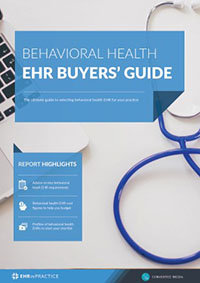3 reasons EHR should be your first point of patient data collection
One of the overarching goals of implementing an electronic health record system into a healthcare practice is to improve the efficiency and quality of operations and clinical care. For this reason, it is important to fully implement and utilize the EHR system as a whole, rather than picking and choosing individual components for implementation.
One area where practices commonly lose productivity and lack smooth operations is patient data collection. Especially early in implementation (and for some practices, on an ongoing basis) many offices fail to utilize EHR when inputting and gathering patient data. Instead, some practices have parallel systems of electronic records and paper records. This prevents them from realizing the full potential of EHR and in some cases causes a decline in productivity.
Here are 3 reasons why EHR should be the first point of patient data collection in a healthcare practice:
1. Increased productivity and operational efficiency
Patient data collection directly into the EHR system will reduce duplication of effort, in which staff do a paper intake first and then transcribe the data into the EHR system. Using the EHR system exclusively will streamline both patient intake processes and clinical documentation time. Furthermore, when the information is input directly into the EHR system there is less risk of mistaken entry, because information is not being transcribed twice. Documenting patient data in real time will also increase the productivity of clinical staff, allowing more patients to be seen and increasing revenue.
EHR Selection Survival Guide - Find the right EHR for patient data collection
2. Improved quality of care
When staff directly enters patient data (everything from insurance and demographic information to lab values, vitals, and treatment plans), the clinician can be certain that the information is accurate, as it is being recorded in real time. The longer the wait between obtaining data to the point of data input, the greater the chance for mistaken data entry. With accurate data, clinicians are able to develop better treatment plans, coordinate with other specialists, and more accurately prescribe medications. This results in improved quality of care and, ultimately, improved patient outcomes.
3. Improved patient satisfaction
Patients trust healthcare practices to provide efficient and reliable care and have little tolerance for mistakes, especially mistakes that are a result of clerical errors. When patient data is collected directly into an EHR system, there is less risk of error due to illegibility, forgetfulness, or distraction. Patients are pleased with an efficiently run office and with timely reporting. When a practice utilizes direct patient data collection, it demonstrates its operational efficiency and commitment to quality patient care and patients respond with higher levels of satisfaction.
Free white paper

EHR Selection Survival Guide
The comprehensive guide to selecting the best EHR system for your medical practice.

Featured white papers
Related articles
-

5 key stakeholders in your EHR selection
Learn about the individuals that, when consulted early and often, can make your EHR selection pro...
-

5 important areas of EHR training during implementation
Successful EHR implementation is not possible without crucial EHR training
-

Top oncology EHRs to kickstart your selection shortlist
Learn about some of the leading oncology EHR systems on the market including CureMD, ARIA Oncolog...



